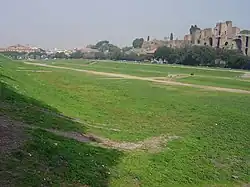馬克西穆斯競技場
馬克西穆斯競技場(義大利語:,拉丁語:,意為「大競技場」)是一個古羅馬競技場,位於義大利羅馬市,坐落於阿文提諾山與帕拉蒂尼山之間。馬克西穆斯競技場是古羅馬時代第一個競技場,也是最大的一座。馬克西穆斯競技場長621公尺(2,037英尺),寬118公尺(387英尺),可以容納150,000人[1]。馬克西穆斯競技場也是古羅馬時代建造競技場的典範。
| 馬克西穆斯競技場 Circus Massimus | |
|---|---|
 | |
| 基本 | |
| 位置 | 義大利羅馬市 |
| 坐标 | |
| 詳細規格 | |
| 長度 | 621公尺(2,037英尺) |
| 寬度 | 118公尺(387英尺) |
| 地圖 | |

歷史
古羅馬時代
在古羅馬著名的歷史學家蒂托·李維巨作《羅馬史》中,描述伊特拉斯坎文明的羅馬國王曾經計畫在競技場高處建造王座,以供羅馬騎士階級與貴族來使用。羅馬王政時代第七任君主盧修斯·塔克文·蘇佩布則在低處為平民設置座位。除此之外,直到羅馬王國晚期,馬克西穆斯競技場很可能仍然小於附近農田的道路,雖然這些道路目前已經消失不見,但是競技場內的木製座位因為容易毀壞,所以經常整修或重建。這些木製座位後來在羅馬王政時代被石製座位所取代。
共和國時代
在西元前494年,獨裁官馬克西穆斯與其後裔獲得權力在東南端設置高官座(curule sea),這裡擁有觀賞競賽的絕佳視野[2]。西元前190年,在監察官的命令之下,跑道兩旁開始設置石製座位,以供元老院成員就坐[3]。
西元前329年開始建造永久性的木造隔間,表面經過粉刷顯得相當明亮[4],前面則有一個匝口,每一個匝口與中央競技場的距離相當。理論上,競技場可以容納25組四馬雙輪戰車並排使用。到了共和國時代晚期至帝國時代早期,馬克西穆斯競技場擁有12個隔間,而12組四馬雙輪戰車可以同時在場上奔馳。人們可以對每個隔間進行投注,而不同的組別也用顏色區別出來[5]。至少從西元前174年開始,人們使用卡斯特與巴勒克斯(Castor and Pollux)蛋雕像來預測馬匹的騎士。西元前33年,巨大的銅製海豚形計數器被設置在競技場中[6]。
凱薩在西元前50年繼續擴張馬克西穆斯競技場,將座位延伸至跑道範圍內。當時馬克西穆斯競技場長621公尺(2,037英尺),寬118公尺(387英尺)。而跑道周圍的水道遭到截斷。歷史學家並不知道馬克西穆斯競技場當時擁有多少座位,古羅馬作家老普林尼認為有250,000個座位[7],但是這個數字不太可信,比較可能是150,000個座位。木製的露天看台於西元前31年被火焚毀[8] 。
帝國時代

屋大維後來將西元前31年遭火焚毀的部分修復完成,部分材料取自屋大維耗費巨資從埃及赫里奧波里斯帶回來的方尖碑,這些方尖碑是埃及人獻給埃及太陽神的象徵[9]。形容馬克西穆斯競技場是羅馬最美麗、最令人稱羨的建築。
可能是因為馬克西穆斯競技場擁有匝口的緣故,所以競技場原本容易遭到水災侵襲[10],直到克勞狄一世在競技場設置防災設施後才得以改善。因為競技場的露天看台與工作房是木造建築,所以容易遭受火災侵襲。西元64年,馬克西穆斯競技場在尼祿統治時期遭遇到羅馬大火,並造成嚴重的傷害。後來馬克西穆斯競技場重新修復完成後,仍然舉行許多競賽與慶典。
西元81年,元老院為了紀念提圖斯,在馬克西穆斯競技場建造一座凱旋門,取代原本的凱旋門。圖密善後來建造一座複合宮殿與馬克西穆斯競技場相連結。因為圖密善喜歡觀賞競賽,所以他在遇刺之前,已經決定修繕馬克西穆斯競技場。在圖拉真時代後,馬克西穆斯競技場並未有重大改變。一些皇帝於競技場中設置一些紀念物,而卡拉卡拉則新建隔間的匝口[11]。
延伸閱讀
- Filippo Coarelli, Guide archéologique de Rome, 1991, p. 225-228 (ISBN 2-01-235428-9)
- Jean-Paul Thuillier, Le Sport dans la Rome Antique, Paris, Errance, 1997
- Humphrey, John, Roman circuses: arenas for chariot racing, University of California Press, 1986.[14]
參考資料
- This is a modern recalculation of the seating capacity at the Circus, a substantial downward revision of Pliny the Elder's estimate of 250,000. For discussion see Humphrey, p. 216.
- In the earliest exercise of the right, a curule chair would have been brought to the spot; its permanent positioning there is unlikely. See Humphrey, p. 61.
- Livy has the plebs seated "promiscuously" (antea in promiscuo spectabant) up to then: see Humphrey, 70.
- Livy, Ab Urbe Condita, 8.20.1
- Humphrey, p. 171; the gates probably used the same animal-sinew torsion springing as the Roman ballista; Ibid, pp. 137 - 138: opposing teams of Reds and Whites are prominent in late Republican literature, and Greens and Blues in the Imperial era. Some Roman authors held that team-racing in multiple colours dated back to the regal era. Ibid, p. 175 for allocation of stalls by lottery.
- Humphrey, pp. 261 - 5.
- Filippo Coarelli, Guide archéologique de Rome, p. 224
- Pliny the Elder's figure of 250,000 circus seats is unreliable; it ignores the necessary interruptions of seating rows by many access stairways and corridors. It might represent a per foot run seating estimate, or include those watching from the nearby heights, outside the building proper. In late Imperial regionary catalogues, seating estimates for the Circus become even wilder; one gives an impossible 450,000 seats. Discussion is in Humphrey, p. 126.
- It was quarried and first dedicated in the reign of Seti I
- The Ludi Martiales of AD 12 were temporarily transferred from the Circus, after a flood.
- Humphrey, pp. 80, 102, 126 - 9. Some repairs were unforeseen and extensive, such as those carried out in Diocletian's reign, after the collapse of a substantial section of seating, which killed some 13,000 people.
- Bowersock, G., Green, P., Grabar, O., Late Antiquity: A Guide to the Postclassical World, Harvard University Press, 1999, p. 674; citing Procopius, The Gothic Wars, 3. 37. 4. (页面存档备份,存于) For the last known beast-hunt at the Circus, see Humphrey, p. 131. Humphrey describes the last known Circus event (549) as "games".
- Partner, Peter, Renaissance Rome, 1500-1559: a portrait of a society, University of Claifornia Press, 1976, pp.4, 166.googlebooks preview (页面存档备份,存于)
- . [2012-03-23]. (原始内容存档于2012-11-14).
外部連結
- 三維重建馬克西穆斯的競技場 (页面存档备份,存于) - www.italyrome.info (页面存档备份,存于)
- Circus Maximus Ipix 360° panorama
- Circus Maximus (页面存档备份,存于) Art & History

